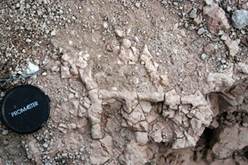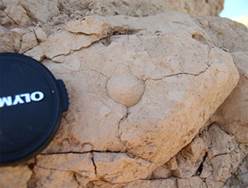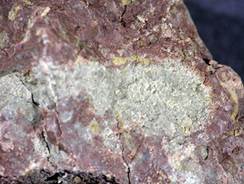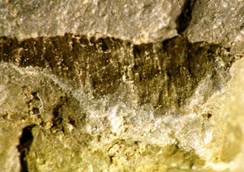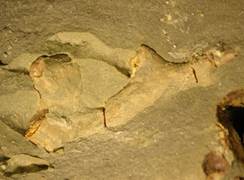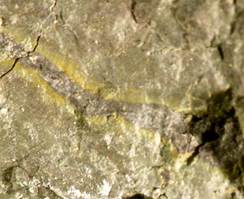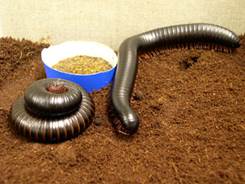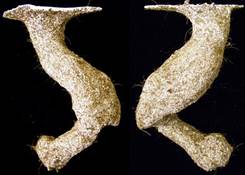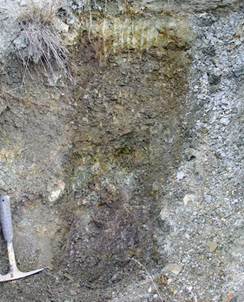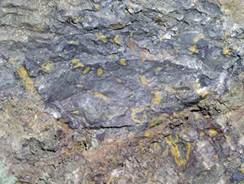|
|
|
Home Dr. Hembree Research Continental Ichnology Laboratory Students Publications Courses News and Opportunities Links
|
|
My research interests lie with the interaction of
sedimentological and biological processes. I am interested in animal-substrate
interactions in ancient and modern continental (or “non-marine”)
environments. These interactions are preserved in the fossil record as trace
fossils. Trace fossils provide an in
situ record of ancient biodiversity, ecology, and environment. The study
of trace fossils, therefore, provides vital information for accurate
paleoenvironmental reconstructions. As sensitive indicators of environmental
and climatic change, ichnofossils are also useful for detailed sequence
stratigraphic analysis. In my research, I interpret the paleoenvironmental,
paleoclimatic, and paleoecological significance of paleosols and ichnofossils
preserved in the geologic record. This involves not only the study of
paleosols and continental trace fossils throughout geologic time, but also
the experimental study of burrowing behaviors of extant terrestrial annelids,
arthropods, amphibians, and reptiles. My current research projects involve
the study of the influence of climate changes on ancient soils and soil
ecosystems including those of the Pennsylvanian and Permian of southeast
Ohio, Permian of eastern Kansas, and the Eocene to Miocene of Colorado and
Wyoming. I am interested in recruiting motivated Master’s students
interested in these research areas.
For more information see News and Opportunities. |
|
Continental Ichnology |
|
|
|
My research in continental ichnology has covered a range of geologic
time and depositional settings. My research on Paleozoic vertebrates of
Kansas has involved the study of the aestivation burrows of the lysorophid amphibian, Brachydectes elongates, from pond deposits within
the Lower Permian Speiser Shale (Hembree et al.,
2004, 2005). These burrows represent the earliest evidence of aestivation
behavior by tetrapods in the fossil record. Aestivation allows aquatic and
semi-aquatic animals to survive long periods of time without water and has
become common among extant amphibians and reptiles. Along with the detailed
study of the surrounding paleosols, associated ichnofossils and body fossils,
these aestivation burrows provide evidence for the interpretation of
seasonality in the Permian of the North American midcontinent. |
Top view of in situ
lysorophid burrow casts in an ephemeral pond
deposit of the Permian Speiser Shale, eastern |
Lysorphid burrow casts (Torridorefugium eskridgensis)
containing skeletal material excavated from the Permian Speiser
Shale, eastern Kansas. |
|
My dissertation research covered a more recent period of
paleoenvironmental change, the late Eocene and early Oligocene. I completed a
detailed study of the ichnofossils associated with paleosols in the White
River Formation of northeastern Colorado (Hembree and Hasiotis, 2007). These
deposits contain the fossils of a number of burrowing vertebrate groups,
including the Amphisbaenia, an order limbless lizard common in modern
tropical to arid environments. The paleosols of the White River Formation
contain a diverse assemblage of continental ichnofossils including those
produced by dung beetles (Pallichnus and Macanopsis),
bees (Celliforma),
ants (Parowanichnus),
earthworms (Edaphichnium),
wasps, beetles, plants, and vertebrates. I used the lateral and vertical
changes in the distribution of ichnofossils to interpret paleoenvironmental
change in the sedimentary basin. Along with ichnofossils I have also applied paleopedologic and sedimentologic
principles to determine which environmental changes within the basin were due
to autogenic and allogenic processes. |
Large rhizoliths (fossil roots) preserved in an Oligocene
paleosol from northeast
Small, elliptical fecal pellets within an Oligocene
paleosol. These are interpreted as earthworm fecal pellets. |
A system of interconnected burrows and chambers
interpreted as a dung beetle nest. Preserved within an Oligocene paleosol.
Cross sectional view of a dung beetle brood burrow in an
Oligocene paleosol. |
|
I am currently studying Pennsylvanian and Permian continental
ichnofossils from the paleosols of southeast Ohio and West Virginia. The
Pennsylvanian-Permian world contained all of the animals that comprise modern
soil ecosystems. The most abundant of these soil organisms were the
arthropods. Pennsylvanian and Permian fossils of arthropod detritovores include millipedes, arthropleurids,
mites, and insects, all of which would have engaged in feeding and dwelling
behaviors in the soil based on comparisons with modern examples. Fossils of
arthropod herbivores include flying insects. These organisms would have had
temporary interaction with the soil through the production of such
reproductive structures as nests or brood burrows. Fossils of arthropod
predators include scorpions and arachnids. Modern arthropod predators
construct burrows for use as dwellings, temporary resting places, and
reproduction. Amphibians and early reptiles, such as microsaurs,
temnospondyls, and cotylosaurs, likely constructed
burrows for use as dwellings, temporary nests, and possibly aestivation. |
Ichnofossils interpreted as millipede burrows from the
Pennsylvanian Casselman Formation, southeast |
Rhizoliths from paleosols of the Pennsylvanian Casselman
Formation. |
|
My research in continental ichnology also involves experimental work with modern organisms, or neoichnology. Through detailed field observation and laboratory experiments with modern burrowing animals, continental tracemakers and their trace morphologies may be correlated to: 1) such substrate conditions as soil texture, moisture, and organic content; 2) depositional environments; and 3) such climatic factors as temperature and precipitation. I have established an animal burrowing laboratory that includes such burrowing animals as scorpions, whip scorpions, spiders, centipedes, millipedes, salamanders, toads, and skinks. A major goal of this research is to develop an online database that provides qualitative and quantitative data on the burrows produced by an array of terrestrial animals, with variations in morphology tied to environmental changes. For more information on this research click here. |
Specimens of the giant African millipede (Archispirostreptus gigas) used in
burrowing experiments. |
Casts of spiral burrows produced by A. gigas burrowing in loose, organic-rich sediment. |
|
|
|
|
|
Paleopedology |
|
|
|
The study of paleosols is important to geologists and biologists
alike. Paleosols provide unique evidence for interpreting ancient terrestrial
ecosystems, environment, and climate. They also provide some of the best
evidence of the evolution of terrestrial ecosystems in addition to a deep
time perspective of the effects of the interaction of terrestrial organisms
and the substrate. I have used paleopedology extensively along with my
studies of continental ichnology. My research has included the study of paleosols
from the Pennsylvanian and Permian of Kansas, Oklahoma, and Ohio, the
Triassic of Colorado, the Eocene of Wyoming, the Oligocene of Colorado, South
Dakota, Nebraska, and Wyoming, and the Miocene of Colorado and Bolivia. In
addition, by studying the characteristics of modern through field work and
laboratory analysis, the pedogenic features preserved in these paleosols have
been used to interpret specific paleoenvironmental and paleoclimatic
conditions. My current research on Pennsylvanian paleosols of Ohio incorporates
field descriptions and laboratory analyses, including the determination of
bulk geochemistry, clay mineralogy, and stable isotope ratios. There is an
extensive record of Pennsylvanian and Permian paleosols in southeastern Ohio and
West Virginia. Exposures of the Allegheny, Conemaugh, Monongahela, and
Dunkard groups in particular allow for both lateral and vertical analyses of
the strata. One 30 m section of the Conemaugh Group, for example, contains 10
different paleosols interpreted as four different soil types based on parent
material, pedogenic modification, and ichnofossils. |
Miocene paleosols in northeast |
Pennsylvanian paleosols in southeast |
|
|
|
|
|
Copyright © 2007 Daniel Hembree Last revised: 5/2019 |
|
|






